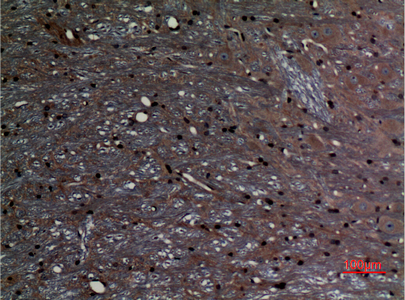ABCG1 Polyclonal Antibody
- Catalog No.:YT5060
- Applications:WB;IHC;IF;ELISA
- Reactivity:Human;Mouse;Rat
- Target:
- ABCG1
- Fields:
- >>ABC transporters;>>Lipid and atherosclerosis
- Gene Name:
- ABCG1
- Protein Name:
- ATP-binding cassette sub-family G member 1
- Human Gene Id:
- 9619
- Human Swiss Prot No:
- P45844
- Mouse Gene Id:
- 11307
- Mouse Swiss Prot No:
- Q64343
- Immunogen:
- Synthesized peptide derived from ABCG1 . at AA range: 560-640
- Specificity:
- ABCG1 Polyclonal Antibody detects endogenous levels of ABCG1 protein.
- Formulation:
- Liquid in PBS containing 50% glycerol, 0.5% BSA and 0.02% sodium azide.
- Source:
- Polyclonal, Rabbit,IgG
- Dilution:
- WB 1:500 - 1:2000. IHC: 1:100-300 ELISA: 1:10000.. IF 1:50-200
- Purification:
- The antibody was affinity-purified from rabbit antiserum by affinity-chromatography using epitope-specific immunogen.
- Concentration:
- 1 mg/ml
- Storage Stability:
- -15°C to -25°C/1 year(Do not lower than -25°C)
- Other Name:
- ABCG1;ABC8;WHT1;ATP-binding cassette sub-family G member 1;ATP-binding cassette transporter 8;White protein homolog
- Observed Band(KD):
- 75kD
- Background:
- The protein encoded by this gene is a member of the superfamily of ATP-binding cassette (ABC) transporters. ABC proteins transport various molecules across extra- and intra-cellular membranes. ABC genes are divided into seven distinct subfamilies (ABC1, MDR/TAP, MRP, ALD, OABP, GCN20, White). This protein is a member of the White subfamily. It is involved in macrophage cholesterol and phospholipids transport, and may regulate cellular lipid homeostasis in other cell types. Six alternative splice variants have been identified. [provided by RefSeq, Jul 2008],
- Function:
- alternative products:Additional isoforms seem to exist,disease:Overexpressed in macrophages from patients with Tangier disease compared to control macrophages. Expressed in foamy macrophages within the atherosclerotic plaque. May play a role in the cholesterol metabolism of macrophages in vitro and in the atherosclerotic plaque.,function:Transporter involved in macrophage lipid homeostasis. Is an active component of the macrophage lipid export complex. Could also be involved in intracellular lipid transport processes. The role in cellular lipid homeostasis may not be limited to macrophages.,induction:Strongly induced in monocyte-derived macrophages during cholesterol influx. Conversely, mRNA and protein expression are suppressed by lipid efflux. Induction is mediated by the liver X receptor/retinoid X receptor (LXR/RXR) pathway. Not induced by bacterial lipopolysaccharides (LPS). Repress
- Subcellular Location:
- Endoplasmic reticulum membrane ; Multi-pass membrane protein . Golgi apparatus membrane ; Multi-pass membrane protein . Cell membrane . Predominantly localized in the intracellular compartments mainly associated with the endoplasmic reticulum (ER) and Golgi membranes.
- Expression:
- Expressed in several tissues. Expressed in macrophages; expression is increased in macrophages from patients with Tangier disease.
Oat fiber inhibits atherosclerotic progression through improving lipid metabolism in ApoE−/− mice. Journal of Functional Foods J Funct Foods. 2019 May;56:14 WB Mouse Liver ,small intestine
RIP140 triggers foam‐cell formation by repressing ABCA1/G1 expression and cholesterol efflux via liver X receptor. FEBS LETTERS 2015 Jan 20 WB Human THP-1 macrophages
Gly[14]-humanin inhibits ox-LDL uptake and stimulates cholesterol efflux in macrophage-derived foam cells. BIOCHEMICAL AND BIOPHYSICAL RESEARCH COMMUNICATIONS 2016 Nov 01 WB Mouse RAW 264.7 macrophages
- June 19-2018
- WESTERN IMMUNOBLOTTING PROTOCOL
- June 19-2018
- IMMUNOHISTOCHEMISTRY-PARAFFIN PROTOCOL
- June 19-2018
- IMMUNOFLUORESCENCE PROTOCOL
- September 08-2020
- FLOW-CYTOMEYRT-PROTOCOL
- May 20-2022
- Cell-Based ELISA│解您多样本WB检测之困扰
- July 13-2018
- CELL-BASED-ELISA-PROTOCOL-FOR-ACETYL-PROTEIN
- July 13-2018
- CELL-BASED-ELISA-PROTOCOL-FOR-PHOSPHO-PROTEIN
- July 13-2018
- Antibody-FAQs
- Products Images

- Western Blot analysis of extracts from K562 cells, using ABCG1 Polyclonal Antibody. Secondary antibody(catalog#:RS0002) was diluted at 1:20000
.jpg)
- Immunohistochemical analysis of paraffin-embedded rat-brain, antibody was diluted at 1:100

- Immunohistochemical analysis of paraffin-embedded rat-brain, antibody was diluted at 1:100



